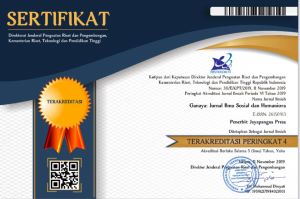Pengembangan Komik Audio Visual Pendidikan Pancasila Berorientasi Kearifan Lokal
DOI:
https://doi.org/10.37329/cetta.v7i4.3652Keywords:
Local Wisdom, Audio-Visual Comics, Pancasila EducationAbstract
The low interest of students in the subject of Pancasila education is often perceived as monotonous and less relevant. There are also impacts caused by the lack of variation in the delivery of Pancasila material, leading students to feel bored and less interested in participating in the learning process. This highlights the need for the development of learning media that is not only informative but also engaging and contextual. This research aims to develop and test the effectiveness of local wisdom-oriented audio-visual comics for Pancasila education aimed at elementary school students. This research uses the Research and Development (R&D) method with a 4-D model, which consists of the defining, designing, developing, and disseminating stages. The research was conducted at the Gugus III Elementary School located in Tejakula District, Buleleng Regency. Data were collected through interviews, questionnaires, and observations, focusing on the feasibility, practicality, and effectiveness of the product. The results show that the developed audio-visual comics are categorized as very good, with an average feasibility score of 81.60. The practicality results from both teachers and students indicate that overall, teachers gave a score of 3.65, categorized as very practical, while students assessed it with a score of 3.84, also categorized as very practical. A significant increase was also observed in student interest after using the local wisdom-oriented audio-visual comics for Pancasila education. These findings indicate that local wisdom-oriented audio-visual comics for Pancasila education are effective in enhancing student interest in Pancasila education and are suitable for integration into the learning process in elementary schools.
References
Arends, R. I. (2012). Learning to Teach. New York: McGraw-Hill.
Arsyad, A. (2017). Media Pembelajaran. Jakarta: RajaGrafindo Persada.
Bandura, A. (1977). Social Learning Theory. Englewood Cliffs, NJ: Prentice-Hall.
Cerovac, M., & Keane, T. (2024). Early Insights Into Piaget’s Cognitive Development Model Through The Lens Of The Technologies Curriculum. International Journal of Technology and Design Education, 30(3), 245-256.
Cohen, J. (1988). Statistical Power Analysis for the Behavioral Sciences (2nd ed.). Hillsdale, NJ: Lawrence Erlbaum Associates.
Dick, W., Carey, L., & Carey, J. O. (2009). The Systematic Design of Instruction. New York: Pearson.
Djamaluddin, M. (2021). Kearifan Lokal Dalam Pendidikan: Membangun Koneksi Sosial Siswa. Jurnal Pendidikan dan Budaya, 10(1), 15-28.
Fitriani, F., & Maemonah. (2023). Perkembangan teori Vygotsky dan implikasi dalam pembelajaran matematika di MIS Rajadesa Ciamis. Jurnal Pendidikan, 10(1), 15-25.
Hamalik, O. (2011). Proses Belajar Mengajar. Jakarta: Bumi Aksara.
Hamzah, B. U. (2013). Teori Motivasi dan Pengukurannya: Analisis di Bidang Pendidikan. Jakarta: Bumi Aksara.
Hidayati, N. (2022). Integrasi nilai lokal dalam kurikulum pendidikan: Efektivitas dan implikasinya. Jurnal Penelitian Pendidikan, 18(2), 45-58.
Indrawan, I. P. O., Sudirgayasa, I. G., & Wijaya, I. K. W. B. (2020). Integrasi kearifan lokal Bali di dunia pendidikan. Prosiding Webinar Nasional Universitas Mahasaraswati Denpasar 2020.
Iskandar, A., & Rahmawati, S. (2023). Pengaruh Materi Ajar Berbasis Kearifan Lokal Terhadap Pemahaman Siswa. Jurnal Pendidikan Pancasila dan Kewarganegaraan, 15(1), 75-90.
Lestari, D., & Anwar, H. (2023). Pentingnya Kearifan Lokal Dalam Pembelajaran Pancasila. Jurnal Pendidikan dan Budaya, 9(2), 112-125.
Maryam, D., Febiola, F., Agami, S. D., & Fawaida, U. (2020). Inovasi Media Pembelajaran Pendidikan Agama Islam Melalui Media Audiovisual. Terampil: Jurnal Pendidikan Dan Pembelajaran Dasar, 7(1), 43-50.
Mayer, R. E. (2009). Multimedia Learning. Cambridge: Cambridge University Press.
Murti, D. K., Gunarhadi, & Winarno. (2020). Development of Educational Comic With Local Wisdom To Foster Morality Of Elementary School Students: A Need Analysis. International Journal of Educational Methodology, 6(2), 337-343.
Putri, S., & Rahman, A. (2021). Efektivitas Media Pembelajaran Interaktif Dalam Meningkatkan Minat Dan Motivasi Belajar Siswa. Jurnal Pendidikan dan Teknologi, 12(3), 90-105.
Ramadhani, A. (2022). Komik Audio Visual Sebagai Media Pembelajaran Interaktif. Jurnal Teknologi Pendidikan, 14(1), 45-58.
Reigeluth, C. M. (1999). Instructional Design Theories and Models: a New Paradigm of Instructional Theory. Mahwah, NJ: Lawrence Erlbaum Associates.
Rukmini, L. (2020). Metode Pengajaran Pancasila: Teori dan Praktik. Jakarta: Penerbit Universitas Pendidikan Indonesia.
Sari, L., & Fitria, M. (2021). Minat Siswa terhadap Pembelajaran Pancasila: Tantangan dan Solusi. Jurnal Pendidikan dan Kearifan Lokal, 8(2), 20-35.
Sari, M., Elvira, D. N., & Aprilia, N. (2024). Media Pembelajaran Berbasis Digital Untuk Meningkatkan Minat Belajar Pada Mata Pelajaran Bahasa Indonesia. Warta Dharmawangsa, 18(1), 205-218.
Setiawan, D. (2020). Teknologi Pendidikan: Teori dan Aplikasi. Yogyakarta: Penerbit Andi.
Supriyadi, R. (2023). Penggunaan Media Interaktif Dalam Pendidikan Pancasila. Jurnal Ilmiah Pendidikan, 18(1), 45-60.
Supriyanto, B. (2020). Pelestarian Kearifan Lokal dalam Kurikulum Pendidikan. Jurnal Pendidikan dan Kearifan Lokal, 7(3), 30-40.
Utami, R. (2022). Media Pembelajaran Inovatif untuk Meningkatkan Motivasi Belajar Siswa. Jurnal Teknologi Pendidikan, 14(2), 100-115.
Vygotsky, L. S. (1978). Mind in Society: The Development of Higher Psychological Processes. Cambridge: Harvard University Press.
Zulkarnaen, M. (2021). Strategi Meningkatkan Minat Belajar Pancasila di Sekolah. Jurnal Ilmiah Pendidikan Pancasila, 8(1), 75-88.
Downloads
Published
How to Cite
Issue
Section
License
Copyright (c) 2024 I Ketut Ngurah Ardiawan

This work is licensed under a Creative Commons Attribution-ShareAlike 4.0 International License.
An author who publishes in the Cetta : Jurnal Ilmu Pendidikan agrees to the following terms:
- Author retains the copyright and grants the journal the right of first publication of the work simultaneously licensed under the Creative Commons Attribution-ShareAlike 4.0 License that allows others to share the work with an acknowledgement of the work's authorship and initial publication in this journal
- Author is able to enter into separate, additional contractual arrangements for the non-exclusive distribution of the journal's published version of the work (e.g., post it to an institutional repository or publish it in a book) with the acknowledgement of its initial publication in this journal.
- Author is permitted and encouraged to post his/her work online (e.g., in institutional repositories or on their website) prior to and during the submission process, as it can lead to productive exchanges, as well as earlier and greater citation of the published work (See The Effect of Open Access).
Read more about the Creative Commons Attribution-ShareAlike 4.0 Licence here: https://creativecommons.org/licenses/by-sa/4.0/.





